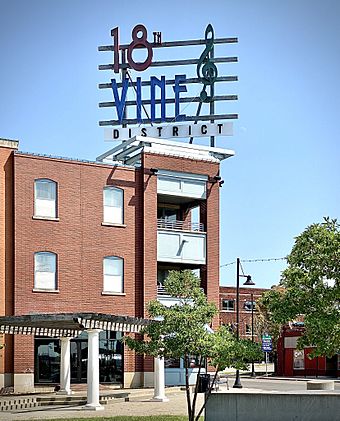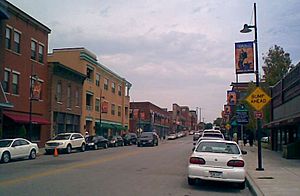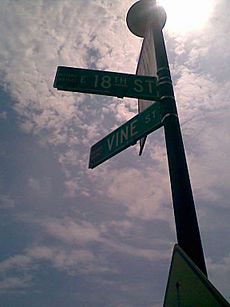18th and Vine – Downtown East, Kansas City facts for kids
Quick facts for kids |
|
|
18th and Vine Historic District
|
|
 |
|
| Location | Roughly bounded by 18th St., Woodland Ave., 19th St. and The Paseo, Kansas City, Missouri |
|---|---|
| Area | 9 acres (3.6 ha) |
| MPS | 18th and Vine Area of Kansas City MPS |
| NRHP reference No. | 84004142 |
| Added to NRHP | September 9, 1991 |
The 18th and Vine area is a special neighborhood in Kansas City, Missouri. It is famous around the world as a key place where jazz music began. It was also a busy center for African-American businesses.
This area helped create a new style of jazz. Other famous jazz spots include Basin Street in New Orleans and Beale Street in Memphis. Kansas City jazz has a unique sound. It uses short, repeated musical ideas called "riffs." It also has a strong blues influence. This style grew from musicians playing together in the district's busy clubs. Many well-known jazz artists from the 1930s and 1940s started their careers here. One famous musician was Charlie Parker. Because of this history, some people say 18th and Vine is one of America's most recognized streets.
In 1991, the area became a national historic district. This means it is protected for its important history. It includes 35 buildings that help tell its story. Later, in 2007, the old city workhouse castle was also added to Kansas City's historical list. It was once a correctional facility from 1897 to 1924.
Contents
A Look Back: History of 18th and Vine
The 18th and Vine neighborhood is just east of Downtown Kansas City. It has always been a key center for African American culture in the area. Its importance was officially recognized in 1991. That's when it was listed on the National Register of Historic Places. This listing included 35 buildings that show the area's rich past.
What You Can See Today
Today, the 18th and Vine district is home to many important places. You can visit the Mutual Musicians Foundation. This is a historic spot where musicians gathered. There's also the Gem Theater, a famous performance venue. The long-time offices of The Call newspaper are here too. This is an important African-American newspaper.
You can also find the Blue Room jazz club. The American Jazz Museum is a great place to learn about jazz history. The Negro Leagues Baseball Museum celebrates African American baseball players. There are also restaurants and apartments in the area. The Historic Lincoln Building is a hub for businesses in the Black community. It was restored in the early 1980s.
The Song "Kansas City"
Six blocks north of 18th and Vine, there was once an intersection of 12th Street and Vine. This spot inspired the famous song "Kansas City" in 1952. Songwriters Jerry Leiber and Mike Stoller wrote it. Many artists have sung this song. These include Little Willie Littlefield, Little Richard, Wilbert Harrison, and the Beatles.
Today, 12th Street and Vine Street no longer cross in the same way. A housing project now stands where they once met. However, the city has placed a street sign in a nearby park. This sign marks the historic spot where 12th Street used to cross Vine.
Working Towards the Future
Over the years, the 18th and Vine District has faced challenges. Many people have worked hard to improve the area. Since the late 1980s, more than $30 million has been invested in the district. People have big plans to bring new life to the neighborhood.
For example, in 2006, there were plans to build 42 homes and a community center. The historic city workhouse castle was part of these plans. This castle was officially added to the Kansas City Register of Historic Places in 2007. From 2016 to 2020, the city government and local groups have continued to propose new projects. These projects aim to restore and improve the historic area.





